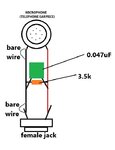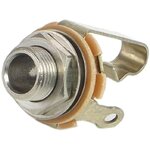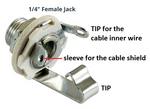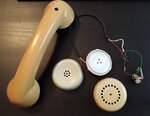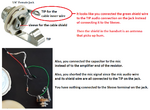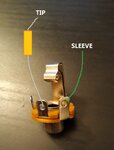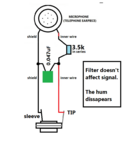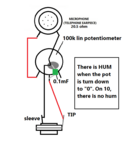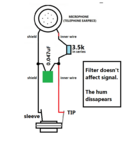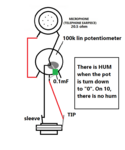bzblues
Full Member level 1
Well, I'm ran out of options. Solder a 100K resistor directly to the female guitar jack, one leg to + and another to -. Then, to make it a lowpass filter I added a capacitor, but of course nothing happened! it sound exactly the same and doesn't cut any high frequencies.
I tryed with the potentiometer once again, with the shielded cable, I put the bare with with the negative wire to the negative terminal of the mic, then solter the bare wire and the negative to the back of the pot aswell the 3rd potentiometer lug. So, STILL HUMMING, the only difference is when I solder the 3rd lug, there is no humming when open or closed, just in the middle. When that lug its not solder to the back of the pot, the humm appears as soo as I close the pot.
The shielded wire didn't make any difference, maybe just a little bit of less humming, but its still very loud. I really don't know what to do.
Maybe its the mic that has a very low reading (20.5 ohms) and I would need the right components for this kind of impedance, but I have no idea how to.
What I don't understand is why the filter works if I use a potentiometer, and doesn't work when I replace the potentiometer with a resistor of the same value (100K) plus the capacitor. It should act as if the potentiometer is closed and the filter should act.
I tryed with the potentiometer once again, with the shielded cable, I put the bare with with the negative wire to the negative terminal of the mic, then solter the bare wire and the negative to the back of the pot aswell the 3rd potentiometer lug. So, STILL HUMMING, the only difference is when I solder the 3rd lug, there is no humming when open or closed, just in the middle. When that lug its not solder to the back of the pot, the humm appears as soo as I close the pot.
The shielded wire didn't make any difference, maybe just a little bit of less humming, but its still very loud. I really don't know what to do.
--- Updated ---
Maybe its the mic that has a very low reading (20.5 ohms) and I would need the right components for this kind of impedance, but I have no idea how to.
--- Updated ---
What I don't understand is why the filter works if I use a potentiometer, and doesn't work when I replace the potentiometer with a resistor of the same value (100K) plus the capacitor. It should act as if the potentiometer is closed and the filter should act.
Last edited:
